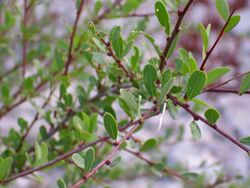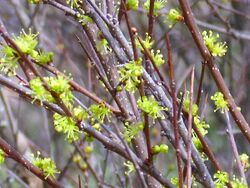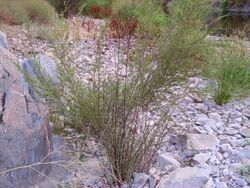Biology:Flueggea tinctoria
| Flueggea tinctoria | |
|---|---|

| |
| Scientific classification | |
| Kingdom: | Plantae |
| Clade: | Tracheophytes |
| Clade: | Angiosperms |
| Clade: | Eudicots |
| Clade: | Rosids |
| Order: | Malpighiales |
| Family: | Phyllanthaceae |
| Genus: | Flueggea |
| Species: | F. tinctoria
|
| Binomial name | |
| Flueggea tinctoria (L.) G.L.Webster
| |
| Synonyms | |
| |
Flueggea tinctoria is a species of flowering shrub in the family Phyllanthaceae, endemic to the Iberian Peninsula.
Description
Flueggea tinctoria is a dioecious, deciduous shrub with up to 2 m (6 ft 7 in) in height, very branchy from the base. Branches are erect-patent, spinescent, cylindrical, smooth or warty, glabrous or puberulous and have short, small and thick hairs. Leaves are alternate and glabrous. Inflorescences have 2-4 (up to 6) fasciculate or solitary flowers, which are erect-patent in a male and sort of pendulous in the female; the pedicel of the male flowers is 2–6 mm (0.079–0.236 in) and in the female 5–8 mm (0.20–0.31 in). It has 5 to 8 very exerted stamens. Fruits are 3.5–4 mm (0.14–0.16 in) in diameter, subglobose, depressed, trisulcate; pedicel is up to 15 mm (0.59 in) long. Seeds are smooth, around 2 mm × 1.5 mm (0.079 in × 0.059 in) and convex on the back and flat laterally.[2]
Distribution and habitat
Flueggea tinctoria is native to the southwest quadrant of the Iberian Peninsula (inland Portugal and centralwestern-southwestern Spain ), a good representative of the western Iberian sclerophyllous and semi-deciduous forests. It inhabits shrubby communities, on flood beds and torrential watercourses, on siliceous terrain, usually stony, from 20 to 200 m (66 to 656 ft) in altitude. It is especially dominant in the river basins of the Guadalquivir, Guadiana, Tagus and Douro.[2][3]
References
- ↑ Rivers, M.C.; Monteiro-Henriques, T.; Carapeto, A.; Buira, A.; García Murillo, P. (2017). "Flueggea tinctoria". IUCN Red List of Threatened Species 2017: e.T96431038A96431043. doi:10.2305/IUCN.UK.2017-3.RLTS.T96431038A96431043.en. https://www.iucnredlist.org/species/96431038/96431043. Retrieved 13 November 2021.
- ↑ 2.0 2.1 "Flueggea tinctoria". Flora Iberica. http://www.floraiberica.es/floraiberica/texto/pdfs/08_108_01%20Flueggea.pdf.
- ↑ "Flueggea tinctoria (L.) G.L.Webster". Flora-On. https://flora-on.pt/#/1Securinega+tinctoria.
Wikidata ☰ Q5863313 entry
 |




